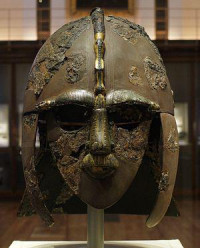|

The ship-burial, probably dating from the early 7th century and excavated in 1939, is one of the most magnificent archaeological finds in England for its size and completeness, far-reaching connections, the quality and beauty of its contents, and the profound interest of the burial ritual itself. The initial excavation was privately sponsored by the landowner. When the significance of the find became apparent, national experts took over. Subsequent archaeological campaigns, particularly in the late 1960s and late 1980s, have explored the wider site and many other individual burials. The most significant artefacts from the ship-burial, displayed in the British Museum, are those found in the burial chamber, including a suite of metalwork dress fittings in gold and gems, a ceremonial helmet, shield and sword, a lyre, and many pieces of silver plate from Byzantium. The ship-burial has from the time of its discovery prompted comparisons with the world described in the heroic Old English poem Beowulf, which is set in southern Sweden. It is in that region, especially at Vendel, that close archaeological parallels to the ship burial are found, both in its general form and in details of the military equipment contained in the burial.






 Please share your ideas with us.
Please share your ideas with us.